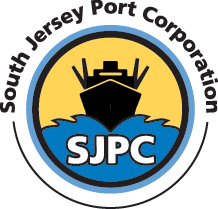The Americanization of the $100 billion offshore wind energy industry is now roaring to life at the South Jersey Port Corporation’s (SJPC) Paulsboro Marine Terminal (PMT), where EEW American Offshore Structures is constructing a state-of-the-art factory to manufacture massive monopile foundations that support huge offshore wind turbines. EEW is the first company to set up a tier-one factory in the United States, with many more offshore wind companies to follow.
For the SJPC, it means jobs and an increase of 250,000 tons of steel cargo flowing annually through PMT. For New Jersey, it means a break away from the pack of states competing for the bounty of jobs and economic development in the green energy economy, with strong support from President Biden and Governor Murphy.
It’s a game-changer in an industry pioneered and developed by Europeans who took the early risks to build and refine a highly reliable and maturing industry whose technologies are now being exported to PMT, giving New Jersey a competitive advantage.
Offshore wind turbines are constructed with monopile foundations that are driven into the ocean floor, the tower that bolts to the monopile, the nacelle that produces the electricity, and the three (3) blades that extend from the nacelle. All of these components are currently manufactured in Europe. Once constructed, EEW will manufacture monopiles at PMT, and more of the offshore wind components and manufacturing are expected to follow.
It’s a critical leap in the Americanization of the supply chain to support the Nation’s offshore wind energy industry and a validation in New Jersey’s heavy investment to fight climate change while also creating family-sustaining jobs in a green energy economy.
New Jersey is going big.
So is President Joseph R. Biden, who has designated New Jersey as the epicenter for the development of 30,000 megawatts of offshore wind energy farms and is backing it up with $3 billion in federal loan guarantees.
New Jersey has invested hundreds of millions of dollars in the industry, and even more investment is planned in the future. In 2005, the SJPC acquired a defunct petrochemical tank farm in Paulsboro, New Jersey, and invested $300 million to turn it into a marine terminal now known as PMT. From the outset, the PMT was engineered with heavy load decks to accommodate the massive weight of offshore energy components.
Doubling down, the New Jersey Economic Development Authority is building a $300 million “Wind Port” in Lower Alloways Township to assemble and deploy the offshore turbines and blades. Turbines and blades are on the New Jersey shopping list.
Monopiles are the indispensable foundation of offshore wind energy farms. They are driven 150 feet into the ocean floor, rise to the surface to support the massive wind towers, turbines, and giant blades that are 850 feet high above the ocean at the highest point.
“Monopiles are massive, and they keep getting bigger as the size of turbines grows, which means we have to keep adapting and making the monopiles larger. We are now targeting diameters of up to 40 feet and lengths of 400 feet long,” said Lee Laurendeau, CEO of EEW American Offshore Structures, the American subsidiary of Germany’s premiere monopile manufacturer EEW Group.
Laurendeau is the New Jersey engineer who built major hi-tech projects worldwide, including the 500,000 square foot Holtec nuclear vessel manufacturing facility at the SJPC’s Broadway Marine Terminal in Camden.
He is building the $250 million clone of EEW’s Rostock, Germany facilities on 80 acres of land at PMT. When it’s complete, he will staff and operate it.
“Our monopiles are five-inch-thick rolled steel cylinders,” he explained. “Comparable in size to the Saturn rocket that sent the astronauts to the moon, a monopile can weigh as much as 5 million pounds each. The final assembly building, currently under construction, is larger than a football field and requires a four-foot-thick solid concrete floor to take the weight.”
Site prep for the 500,000 square foot building complex is well underway. Concrete foundations will be poured this Spring. Construction of the steel frames, roof, and skin is scheduled throughout the Summer—installation of mechanicals throughout next fall. The facility is planned for operations by 2023 to deliver monopiles for Orsted’s 1,100 MW project off the coast of Atlantic City, New Jersey.
The factory construction will create hundreds of union construction jobs and when in full operation, will employ hundreds of workers from welders to accountants.
Building a monopile is similar to building a ship. Massively powerful machines roll the long slabs of steel into rings. The rings are joined together to make the massive pipe. The portion of the monopile exposed to seawater is sandblasted and given three coats of epoxy paint for protection.
Initially, the rolled steel rings will be imported as the Paulsboro plant ramps to full capabilities. The company will rely on both domestic and foreign steel predicated on quality, price, and availability.
The 2,500-ton monopiles are moved horizontally onto barges by multi-wheeled heavy-lift carriers, barged out to the ocean construction site, and driven 100 to 150 feet into the ocean floor.
While construction of the turbine farms is a summer job, building the monopiles is a year-round job. EEW will manufacture about 100 monopiles a year, store them on open land until deployed in the Summer.
EEW and New Jersey are strategically located to service the entire Atlantic Coast offshore wind industry and expect to be producing monopiles for decades to come.
Want to know more? View the Southern New Jersey Economic Development Council’s roundtable discussion here.



